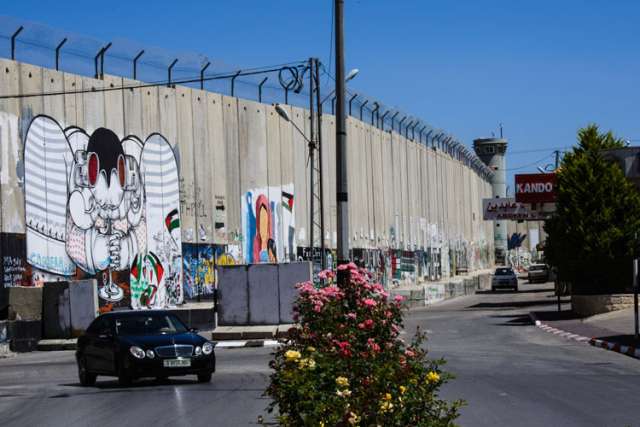In the Middle East in this century, battles are won in the newspapers and magazines of the West, at film festivals, in books and on university campuses. Hundreds of thousands of American soldiers over more than a decade failed in Iraq. There is no military solution in Syria. Israeli military dominance has not brought Israel peace or victory.
In this century, artists, journalists, film makers have the power armies once had to establish the facts on the ground – political and cultural facts. And the politics of our age most certainly are cultural. The greatest Palestinian victory of this decade has been paintings by international art star Banksy on or near Israel's security wall in Bethlehem.
These paintings of a child releasing balloons, a dove wearing a bullet proof vest and caught in a sniper's sights, a little girl patting down an Israeli soldier, a soldier checking a donkey's identification card as it enters Bethlehem have become weapons the Palestinians wield against the idea of any legitimate claim Israel has on land its army over ran in 1967.
The images are stark, simple and memorable. They draw a moral line in the sand to say that the use of organized force in the service of political goals is always wrong. The pictures assign guilt to Israel and its army and innocence to Palestinian victims.
Banksy only began a constantly evolving artistic transformation of the wall. Other artists have come to apply their style and their politics to the world's most hated canvas. While there's variation in the style, there's none in the politics.
Most of the graffiti is not art. It's classic spray painted scrawl. Most of it is in English. Arabic is almost absent, though there's plenty of Spanish, Portuguese and German.
The religious imagery on the wall is all Christian. The sacred heart of Jesus, an attempt at a Madonna and child and many crosses are among the images. There are no crescent moons or minaret towers.
This is an international intifada of art. The millions of tourists and pilgrims who have passed through Bethlehem have seen the wall and taken pictures. They've posted those pictures on Facebook and tweeted them to their friends.
When Pope Benedict last visited he stood on a dais in front of the wall with Palestinian Authority President Mahmoud Abbas and other Palestinian notables. His speech that day is not much quoted, but pictures of Benedict before the wall have moved through the world's consciousness.
Pope Benedict himself was never associated with that passionate certainty about the wrongs of the powerful and the rights of the weak. He was not a cultural touchstone for those who wear a Palestinian kaffiyeh (the distinctive scarf which came to be associated with Yasser Arafat) with their weekend clothes.
This was unfair to Benedict, who was as suspicious of capitalism and as horrified by war as any leader has been in the last 200 years.
But Pope Francis has captured the imagination of many kaffiyeh-wearing, anti-capitalist advocates for justice and liberation. The photograph that we all expect of Francis in front of the wall will, even if he says nothing, strike a blow against Israel's security state, its desire to maintain suburbs in the West Bank and its claim upon American support. Israel has a lively press and regular elections but the wall does not shout out democracy.
Pope Francis has no soldiers (the Swiss guard are a troop of extras on the set) but he has power that Bismark might envy or fear. It is the power of image, gesture and words applied to the moral truth of our lives, our politics and our nations.


